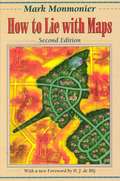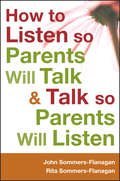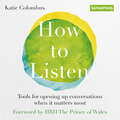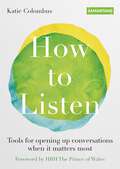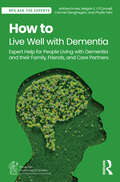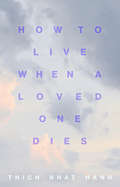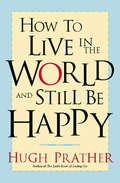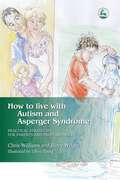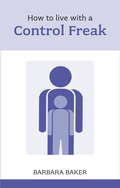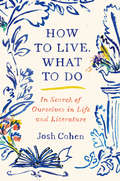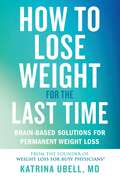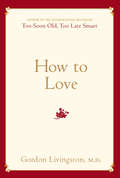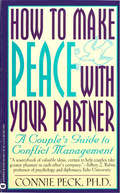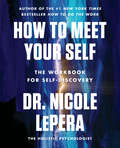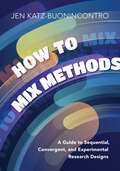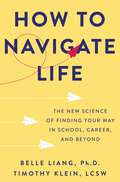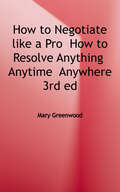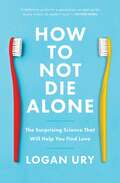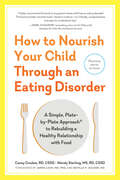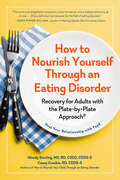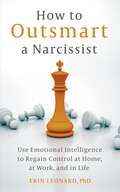- Table View
- List View
How to Lie with Maps 2nd Edition
by Mark MonmonierOriginally published to wide acclaim, this lively, cleverly illustrated essay on the use and abuse of maps teaches us how to evaluate maps critically and promotes a healthy skepticism about these easy-to-manipulate models of reality. Monmonier shows that, despite their immense value, maps lie. In fact, they must.
How to Lie with Maps: Second Edition
by Mark MonmonierOriginally published to wide acclaim, this lively, cleverly illustrated essay on the use and abuse of maps teaches us how to evaluate maps critically and promotes a healthy skepticism about these easy-to-manipulate models of reality. Monmonier shows that, despite their immense value, maps lie. In fact, they must. The second edition is updated with the addition of two new chapters, 10 color plates, and a new foreword by renowned geographer H. J. de Blij. One new chapter examines the role of national interest and cultural values in national mapping organizations, including the United States Geological Survey, while the other explores the new breed of multimedia, computer-based maps. To show how maps distort, Monmonier introduces basic principles of mapmaking, gives entertaining examples of the misuse of maps in situations from zoning disputes to census reports, and covers all the typical kinds of distortions from deliberate oversimplifications to the misleading use of color. "Professor Monmonier himself knows how to gain our attention; it is not in fact the lies in maps but their truth, if always approximate and incomplete, that he wants us to admire and use, even to draw for ourselves on the facile screen. His is an artful and funny book, which like any good map, packs plenty in little space. " "Scientific American" "A useful guide to a subject most people probably take too much for granted. It shows how map makers translate abstract data into eye-catching cartograms, as they are called. It combats cartographic illiteracy. It fights cartophobia. It may even teach you to find your way. For that alone, it seems worthwhile. " Christopher Lehmann-Haupt, "The New York Times" . " . . witty examination of how and why maps lie. The book] conveys an important message about how statistics of any kind can be manipulated. But it also communicates much of the challenge, aesthetic appeal, and sheer fun of maps. Even those who hated geography in grammar school might well find a new enthusiasm for the subject after reading Monmonier's lively and surprising book. " "Wilson Library Bulletin" "A reading of this book will leave you much better defended against cheap atlases, shoddy journalism, unscrupulous advertisers, predatory special-interest groups, and others who may use or abuse maps at your expense. " John Van Pelt, "Christian Science Monitor" "Monmonier meets his goal admirably. . . . His] book should be put on every map user's 'must read' list. It is informative and readable . . . a big step forward in helping us to understand how maps can mislead their readers. " Jeffrey S. Murray, "Canadian Geographic""
How to Listen so Parents Will Talk and Talk so Parents Will Listen
by John Sommers-Flanagan Rita Sommers-Flanagan"In keeping with person-centered theory and therapy, John and Rita Sommers-Flanagan have produced a book that will be immensely helpful for professionals who work with parents. Throughout the pages, there are many examples of practitioners honoring and respecting parents and listening deeply to how best be of help. I am delighted that this book continues to echo and expand on my father's work." —Natalie Rogers, PhD, REAT, author, The Creative Connection and The Creative Connections for Groups "Because parenting can be such a dizzying task, professionals working with parents need to have intelligible, compassionate, and ethical principles to guide their work. John and Rita Sommers-Flanagan have mastered this complex terrain, and we are fortunate, in this articulate and accessible book, to gain from their exceptional experience and wisdom." —Andrew Peterson, EdD, author, The Next Ten Minutes: 51 Absurdly Simple Ways to Seize the Moment Step-by-step guidance for building healthy dialogues with parents that open communication and promote positive outcomes Embracing the uniqueness of every parent, family situation, and practitioner, How to Listen so Parents Will Talk and Talk so Parents Will Listen helps professionals address the parent-child problems that families often find puzzling or challenging and for which they seek support and guidance. How to Listen so Parents Will Talk and Talk so Parents Will Listen features many specific interventions and methods for helping parents implement developmentally appropriate and scientifically supported strategies for building healthy parent-child relationships and working through the most common conflicts encountered in families. It includes: Tips for creating a positive therapist-client experience with parents Guidelines for working with a variety of parents Parenting tip sheets and homework assignments Case studies focusing on many different parenting problems, including the strong-willed child, divorce, homework battles, spanking, and more How to Listen so Parents Will Talk and Talk so Parents Will Listen will help you develop positive relationships with parents so that constructive two-way dialogue can be established. Even the most difficult and resistant parents can be successfully engaged through the helpful strategies, advice, and tools found in this practical guide.
How to Listen: Tools for opening up conversations when it matters most
by Katie Colombus Samaritans The Samaritan Enterprises LimitedListening helps us be there for others, to support them in tough times, and to strengthen our relationships with partners, family, friends and colleagues. From opening up a conversation with someone who might be struggling, to how to use gentle encouragement to help others share their stories, How to Listen demonstrates the power of listening without judgement and draws on the extensive experience of Samaritans in offering practical advice to apply to your own life. Friendly and approachable, with a preface by Michael Palin, it includes helpful tips from trained Samaritans on how to talk about how we are feeling, as well as how to listen to one another in a way that can prevent day-to-day concern or worry from escalating into more complex emotions.(p) 2020 Octopus Publishing Group
How to Listen: Tools for opening up conversations when it matters most
by Katie Colombus Samaritans The Samaritan Enterprises LimitedForeword by HRH The Prince of WalesPreface by Michael PalinListening helps us be there for others, to support them in tough times, and to strengthen our relationships with partners, family, friends and colleagues. From opening up a conversation with someone who might be struggling, to how to use gentle encouragement to help others share their stories, How to Listen demonstrates the power of listening without judgement and draws on the extensive experience of Samaritans in offering practical advice to apply to your own life. Friendly and approachable, with a preface by Michael Palin, it includes helpful tips from trained Samaritans on how to talk about how we are feeling, as well as how to listen to one another in a way that can prevent day-to-day concern or worry from escalating into more complex emotions.
How to Listen: Tools for opening up conversations when it matters most
by Katie Colombus Samaritans The Samaritan Enterprises LimitedForeword by HRH The Prince of WalesPreface by Michael PalinListening helps us be there for others, to support them in tough times, and to strengthen our relationships with partners, family, friends and colleagues. From opening up a conversation with someone who might be struggling, to how to use gentle encouragement to help others share their stories, How to Listen demonstrates the power of listening without judgement and draws on the extensive experience of Samaritans in offering practical advice to apply to your own life. Friendly and approachable, with a preface by Michael Palin, it includes helpful tips from trained Samaritans on how to talk about how we are feeling, as well as how to listen to one another in a way that can prevent day-to-day concern or worry from escalating into more complex emotions.
How to Live Well with Dementia: Expert Help for People Living with Dementia and their Family, Friends, and Care Partners (BPS Ask The Experts in Psychology Series)
by Anthea Innes Megan E. O’Connell Carmel Geoghegan Phyllis FehrHow to Live Well with Dementia: Expert Help for People Living with Dementia and their Family, Friends, and Care Partners provides an array of essential guidance about the different aspects of dementia for all whose lives are touched by dementia, including people living with dementia and their support network.Following an effective Q&A framework, this book offers valuable, easy-to-navigate guidance on the burning questions that those living with a dementia diagnosis and their carer/supporter need to know. Questions addressed include ‘How can I adjust to life with the diagnosis?’, ‘How can I plan for the future?’, and ‘How can we support our loved ones living with dementia?’. It provides expert explanations about changes in the brain and the various causes and types of dementia, as well as support on how to adjust to living with a diagnosis. It also offers practical information about care planning and advanced directives, maintaining health and social connections, accessing appropriate community care, and supporting medical and hospital care. It concludes with important self-care information for care/support partners.Written jointly by academic experts and experts through lived experience, this book is indispensable for people living with dementia, care partners, and anyone wanting to understand more about the condition, as well as health and social care professionals and students of health and social care.
How to Live When a Loved One Dies: Healing Meditations for Grief and Loss
by Thich Nhat HanhIn this comforting book that will offer relief to anyone moving through intense grief and loss, Zen Master Thich Nhat Hanh shares accessible, healing words of wisdom to transform our suffering.In the immediate aftermath of a loss, sometimes it is all we can do to keep breathing. With his signature clarity and compassion, Thich Nhat Hanh will guide you through the storm of emotions surrounding the death of a loved one.How To Live When A Loved One Dies offers powerful practices such as mindful breathing that will help you reconcile with death and loss, feel connected to your loved one long after they have gone, and transform your grief into healing and joy.
How to Live in the World and Still Be Happy
by Hugh PratherYour Go-to Guide for Finding HappinessLife got you down? Discover the cure to gloomy days in this book—packed with wisdom and inspiration guaranteed to bring your smile back.The obstacles to your happiness. There are a lot of things in life that we worry and stress about. Our jobs, relationships, and possessions are important to us, and because of that, we look to them for happiness. But when they ultimately disappoint us, they act as obstacles to attaining that very happiness we thought they would bring. In this motivational book, author Hugh Prather urges readers to let go of attitudes that hold us back from experiencing happiness.How to live a happy life. When we recognize and address the obstacles in our lives, we open the door for happiness to come in. But it doesn’t happen without putting in the work. During his years of counseling, Prather learned and developed an actual program for being happy. Through following this program, and examining our own lives, we can learn how to actively work towards achieving the happiness we all long for.In How to Live in the World and Still Be Happy learn:How to find your happy life with the help of concrete exercisesAbout the obstacles that may be standing in your wayThe benefits of an inspirational guide that you can return to again and againIf you enjoyed books like Resisting Happiness, How to Be Happy (Or at Least Less Sad), A Year of Positive Thinking, or Get Out of Your Own Way, then your next read should be How to Live in the World and Still Be Happy by Hugh Prather.
How to Live with Autism and Asperger Syndrome: Practical Strategies for Parents and Professionals
by Christine Williams Olive Young Joanne BrayshawThis accessible and valuable introduction to caring for a child with autism is an ideal resource for teachers and members of a child with autism's immediate and extended family. In clear and simple language, with many illustrations, the authors tackle common problems experienced in everyday routines such as eating, sleeping and going to the toilet, as well as how to cope with aggression and tantrums, preoccupations and compulsions and how to enable better communication and socialising. Based on up-to-date research and using many case examples, the authors consider step-by-step why each problem may be happening and suggest a number of solutions.
How to Live with a Control Freak
by Barbara BakerDo you live with a controlling partner? Someone who always wants to make the decisions, about where you go on holiday or what you spend on clothes? Someone who needs to know where you are or what you are doing? Or maybe you work with a control freak? Even though you've got the talent, this person takes all the limelight and can't let go enough to let you get on with your job. Control freaks come in all shapes and sizes. Often they happen to be the people we love. Your friends and family may say 'Why don't you just leave them?', but it's not always that simple, especially if you still love the person and have good times together. This book looks at how and why controlling patterns develop in relationships, and what you can do about it if you're in the middle of one. Topics include: why people become control freaks; what it's really like to live or work with one; understanding how a control freak ticks; how to live with a control freak - without losing yourself in the process; living with a controlling partner, boss, colleague or child; and, what to do if you're the control freak - a comprehensive self-help section.
How to Live with a Control Freak
by Barbara BakerDo you live with a controlling partner? Someone who always wants to make the decisions, about where you go on holiday or what you spend on clothes? Someone who needs to know where you are or what you are doing? Or maybe you work with a control freak? Even though you've got the talent, this person takes all the limelight and can't let go enough to let you get on with your job. Control freaks come in all shapes and sizes. Often they happen to be the people we love. Your friends and family may say 'Why don't you just leave them?', but it's not always that simple, especially if you still love the person and have good times together. This book looks at how and why controlling patterns develop in relationships, and what you can do about it if you're in the middle of one. Topics include: why people become control freaks; what it's really like to live or work with one; understanding how a control freak ticks; how to live with a control freak - without losing yourself in the process; living with a controlling partner, boss, colleague or child; and, what to do if you're the control freak - a comprehensive self-help section.
How to Live. What to Do: In Search of Ourselves in Life and Literature
by Josh CohenA brilliant psychoanalyst and professor of literature invites us to contemplate profound questions about the human experience by focusing on some of the best-known characters in literature—from how Virginia Woolf&’s Mrs. Dalloway copes with the inexorability of midlife disappointment to Ruth's embodiment of adolescent rebellion in Kazuo Ishiguro&’s Never Let Me Go. &“So beautiful ... a fantastic book.&” —Zadie Smith, best-selling author of White TeethIn supple and elegant prose, and with all the expertise and insight of his dual professions, Josh Cohen explores a new way for us to understand ourselves. He helps us see what Lewis Carroll&’s Alice and Harper Lee&’s Scout Finch can teach us about childhood. He delineates the mysteries of education as depicted in Jane Eyre and as seen through the eyes of Sandy Stranger in The Prime of Miss Jean Brodie. He discusses the need for adolescent rebellion as embodied in John Grimes in James Baldwin&’s Go Tell It on the Mountain and in Ruth in Kazuo Ishiguro&’s Never Let Me Go. He makes clear what Goethe&’s Young Werther and Sally Rooney&’s Frances have—and don&’t have—in common as they experience first love; how Middlemarch&’s Dorothea Brooke deals with the vicissitudes of marriage. Vis-a-vis old age and death, Cohen considers what wisdom we may glean from John Ames in Marilynne Robinson&’s Gilead and from Don Fabrizio in Giuseppe Tomasi di Lampedusa&’s The Leopard.Featuring: • Alice—Lewis Carroll, Alice's Adventures in Wonderland / Through the Looking Glass • Scout Finch—Harper Lee, To Kill a Mockingbird • Jane Eyre—Charlotte Brontë, Jane Eyre • John Grimes—James Baldwin, Go Tell It on the Mountain • Ruth—Kazuo Ishiguro, Never Let Me Go • Vladimir Petrovitch—Ivan Turgenev, First Love • Frances—Sally Rooney, Conversations with Friends • Jay Gatsby—F. Scott Fitzgerald, The Great Gatsby • Esther Greenwood—Sylvia Plath, The Bell Jar • Clarissa Dalloway—Virginia Woolf, Mrs. Dalloway • And more!
How to Lose Weight for the Last Time: Brain-Based Solutions for Permanent Weight Loss
by Katrina UbellThe missing piece to the most sought-after health goal, How to Lose Weight for the Last Time offers brain-based solutions for dropping pounds and keeping them off without suffering or sacrifice. As a pediatrician, Katrina Ubell, MD, always struggled with her weight--she was either 40 pounds overweight, or struggling to lose that weight. Although she'd regularly counsel parents on the importance of keeping their kids healthy and fostering good eating habits, Dr. Ubell, as a busy professional, was never able to do the same for herself. Like everyone else, she tried many different diets and programs, but would always regain the weight. In 2015, Dr. Ubell "cracked the code" for making weight loss permanent, and developed a program targeted at busy physicians like herself who often de-prioritize their own wellness. As a weight loss coach, Dr. Ubell has helped over 1,000 busy physicians and professionals find and stay at a healthy weight with her brain-based program, and is now ready to bring this program to the general public. Dr. Ubell's program doesn't involve any unrealistic diets, plans, special foods, supplements, or even rigorous exercise protocols; instead, she uses a deep understanding of the brain and behavior patterns to get results. Through her work, she has been able to uncover and speak into the universal obstacles that stand in our way of losing and keeping off weight.
How to Love: Choosing Well at Every Stage of Life
by Gordon LivingstonDr. Gordon Livingston-a physician of the human heart, a philosopher of human psychology-offers an urgently needed meditation on who best (and who best not) to love. As in his previous books, Dr. Livingston demonstrates an unerring sense of what is important, providing readers with a much-needed alternative to the trial-and-error learning that makes wisdom such an expensive commodity.
How to Make Peace with Your Partner: A Couple's Guide to Conflict Management
by Connie PeckUse the skills of professional negotiators to solve everyday household issues.
How to Meet Your Self: The Workbook For Self-discovery
by Dr. Nicole LePeraFrom Dr. Nicole LePera, author of the #1 New York Times bestseller How to Do the Work, comes an interactive workbook offering a practical roadmap for self-healing.At the root of all healing work is awakening consciousness, a process of shining light into the darkness of the unknown. In recent years, Dr. Nicole LePera has become the leading voice in psychological self-healing, helping millions of people around the world rise out of survival mode to consciously create authentic lives they love.In her first book, How to Do the Work, Dr. Nicole offered readers a revolutionary, holistic framework for self-healing. Now, in How to Meet Your Self, she shares an interactive workbook designed to help every reader uncover their Authentic Self. By objectively and compassionately observing the physical, mental, and emotional patterns that fill our days and create our current selves, we can more clearly see what we do not wish to carry into the future.We all fall into conditioned habits and patterns—products of our past—that lead to cycles of pain, stuckness, and self-destruction. But as Dr. Nicole shares, we also have the innate ability to awaken to and change the behaviors and habits that no longer serve us, allowing us to step into the highest versions of ourselves. And as you work through this book and witness these default habits, from sleep to movement to eating, through emotional reactivity and core beliefs, you will never again have to ask: “but where do I start?”How to Meet Your Self is a revolutionary guide, a kind and encouraging companion, and a comprehensive masterwork of self-understanding that will radically transform your inner work and outer world.
How to Mix Methods: A Guide to Sequential, Convergent, and Experimental Research Designs
by Jen Katz-BuonincontroThis book shows researchers in education, psychology, health, and other social sciences how to mix qualitative and quantitative research methods together with confidence. How can researchers sequence and incorporate data in ways that are meaningful, without simply combining data and hoping it makes sense? This book walks readers through the essential steps to avoid some common mistakes and to clarify confusing parts of common method designs. It offers a series of "how-to" steps, situated within the core mixed methods designs. Students and researchers will learn the 10 essential design elements of all mixed methods research, how to clearly distinguish between the different core mixed methods designs, how to figure out which design works best for their research, and more.
How to Navigate Life: The New Science of Finding Your Way in School, Career, and Beyond
by Belle Liang PhD Timothy Klein LCSWAn essential guide to tackling what students, families, and educators can do now to cut through stress and performance pressure, and find a path to purpose.Today’s college-bound kids are stressed, anxious, and navigating demands in their lives unimaginable to a previous generation. They’re performance machines, hitting the benchmarks they’re “supposed” to in order to reach the next tier of a relentless ladder. Then, their mental and physical exhaustion carries over right into first jobs. What have traditionally been considered the best years of life have become the beaten-down years of life. Belle Liang and Timothy Klein devote their careers both to counseling individual students and to cutting through the daily pressures to show a better way, a framework, and set of questions to find kids’ “true north”: what really turns them on in life, and how to harness the core qualities that reveal, allowing them to choose a course of study, a college, and a career. Even the gentlest parents and teachers tend to play into pervasive societal pressure for students to PERFORM. And when we take the foot off the gas, we beg the kids to just figure out what their PASSION is. Neither is a recipe for mental or physical health, or, ironically, for performance or passion. How to Navigate Life shows that successful human beings instead tap into their PURPOSE—the why behind the what and how. Best of all, purpose is a completely translatable quality to every aspect of life, from first jobs to last jobs and everything in between.
How to Negotiate Like a Pro: How to Resolve Anything, Anytime, Anywhere
by Mary GreenwoodIf you can't seem to get what you want, it's time to learn how to negotiate like a pro. <p><p>In this third revised and updated edition of How to Negotiate like a Pro: How to Resolve Anything, Anytime, Anywhere (the first two editions won nine book awards), Greenwood, with over 30 years of experience, has added a new chapter on How to Negotiate with Difficult People, including pathological liars, narcissists, and bullies. <p><p>Here is a sample of tips you will learn: --Gain strategies and practical tips for the negotiation process --Learn what makes a good negotiator --Close the deal --Strategize how to win with a narcissist --Learn the ten questions to get the best deal --Find out how to get the best salary and not leave money on the table. After reading Greenwood's 41 rules, you will soon be negotiating like a pro.
How to Not Die Alone: The Surprising Science That Will Help You Find Love
by Logan UryA &“must-read&” (The Washington Post) funny and practical guide to help you find, build, and keep the relationship of your dreams—from the Harvard-trained behavioral scientist and featured dating coach on Netflix&’s The Later Daters.Have you ever looked around and wondered, &“Why has everyone found love except me?&” You&’re not the only one. Great relationships don&’t just appear in our lives—they&’re the culmination of a series of decisions, including whom to date, how to end it with the wrong person, and when to commit to the right one. But our brains often get in the way. We make poor decisions, which thwart us on our quest to find lasting love. Drawing from years of research, behavioral scientist turned dating coach Logan Ury reveals the hidden forces that cause those mistakes. But awareness on its own doesn&’t lead to results. You have to actually change your behavior. Ury shows you how. This &“simple-to-use guide&” (Lori Gottlieb, New York Times bestselling author of Maybe You Should Talk to Someone) focuses on a different decision in each chapter, incorporating insights from behavioral science, original research, and real-life stories. You&’ll learn: -What&’s holding you back in dating (and how to break the pattern) -What really matters in a long-term partner (and what really doesn&’t) -How to overcome the perils of online dating (and make the apps work for you) -How to meet more people in real life (while doing activities you love) -How to make dates fun again (so they stop feeling like job interviews) -Why &“the spark&” is a myth (but you&’ll find love anyway) This &“data-driven&” (Time), step-by-step guide to relationships, complete with hands-on exercises, is designed to transform your life. How to Not Die Alone will help you find, build, and keep the relationship of your dreams.
How to Nourish Your Child Through an Eating Disorder: A Simple, Plate-by-plate Approach® To Rebuilding A Healthy Relationship With Food
by Wendy Sterling Casey CrosbieA revolutionary, entirely visual approach to helping your child overcome their eating disorder (ED) and eat normally again that does away with counting calories and measuring food—rooted in the leading evidence-based approach: Family-Based Therapy (FBT) Parents are the first to know when their child starts behaving differently. Has your son stopped eating his favorite food, or does he refuse to eat out with friends? Has your daughter drastically increased her exercise regimen, or become obsessed with health foods? These are among the telltale signs that your child, like millions of others, may have an eating disorder (ED). In this essential guide, registered dietitians Casey Crosbie and Wendy Sterling introduce an all-new strategy you can use to help your child at home. The Plate-by-Plate approach is rooted in family-based treatment (FBT)—the leading psychological therapy for EDs. Unlike complicated “exchange” systems, this is simple: Crosbie and Sterling coach you through every aspect of meeting your child’s nutritional needs, using just one tool—a ten-inch plate. Paired with therapy, this intuitive, visual method is the best way to support your child on the path to recovery. Plus, the authors cover how to talk about diet and weight, what to do while traveling, what to expect from your child’s doctor, and much more.
How to Nourish Yourself Through an Eating Disorder: Recovery For Adults With The Plate-by-plate Approach®
by Wendy Sterling Casey CrosbieOvercome your eating disorder and repair your relationship with food, starting today If you struggle with anorexia, bulimia, binge eating, or another form of disordered eating, the path to normal eating may seem impossible. This is why Wendy Sterling and Casey Crosbie created the Plate-by-Plate Approach®: a simple, numberless, exchange-free program to restore your relationship with food. In this practical, easy-to-use guide—complete with sample plates, example schedules, and helpful tracking logs—they teach you to take control of your nutrition with nothing more than a 10-inch plate. Learn to use the Plate-by-Plate Approach® at home. Understand common patterns and behaviors to restore your relationship with food. Adapt the Plate-by-Plate Approach® to your own dietary and cultural needs. Overcome common barriers on your journey to healthy eating. How to Nourish Yourself Through an Eating Disorder transforms the challenging path to recovery, simplifying your treatment plan and provide a straightforward, intuitive, tried-and-true method for a better life.
How to Outsmart a Narcissist: Use Emotional Intelligence to Regain Control at Home, at Work, and in Life
by Erin LeonardIt might be surprising to learn that the emotional qualities that allow you to remain close to others, empathize, collaborate, compromise, perspective-take, and easily resolve conflict, in most healthy relationships, can actually backfire with a narcissist.Why? Because you see the good. You trust. You empathize. These emotionally intelligent attributes keep you connected to others and help you resolve conflict amicably and maintain healthy relationships.Written by psychotherapist and attachment expert, Dr. Erin Leonard, How to Outsmart a Narcissist breaks down how a narcissist manipulates and exploits these traits and details strategies to protect yourself against their attacks, whether they come from a romantic partner, a work colleague, a spouse, a co-parent, or a family member.Filled with relatable stories, emotionally intelligent solutions, and practical advice to help you outsmart the narcissist in your life, this is your guide to finally finding peace from their chaos.
How to Outsmart a Narcissist: Use Emotional Intelligence to Regain Control at Home, at Work, and in Life
by Erin LeonardIt might be surprising to learn that the emotional qualities that allow you to remain close to others, empathize, collaborate, compromise, perspective-take, and easily resolve conflict, in most healthy relationships, can actually backfire with a narcissist.Why? Because you see the good. You trust. You empathize. These emotionally intelligent attributes keep you connected to others and help you resolve conflict amicably and maintain healthy relationships.Written by psychotherapist and attachment expert, Dr. Erin Leonard, How to Outsmart a Narcissist breaks down how a narcissist manipulates and exploits these traits and details strategies to protect yourself against their attacks, whether they come from a romantic partner, a work colleague, a spouse, a co-parent, or a family member.Filled with relatable stories, emotionally intelligent solutions, and practical advice to help you outsmart the narcissist in your life, this is your guide to finally finding peace from their chaos.
